Back in September, I published a six-part series, "When will the economy start to add jobs?" . The research in that series led me to conclude that it was most probable that the jobs market would bottom and start to add jobs in November or December, +/- 1 month. Here's a recap of my discussions of each of the above indicators, and why they suggest this Expansion probably isn't a "Jobless Recovery" any more -- or at least won't be after January.
The 4 "Leading Indicators" I found, which in the past have specifically portended job growth, typically turn in the following order:
(1) Real retail sales bottom and turn.
(2) Initial Jobless claims turn.
(3) The ISM manufacturing index turns above 50, i.e., signals actual growth.
(4) Industrial Production turns.
(5) ISM manufacturing index is above 53, ISM employment is at (- 5) or above, initial jobless claims are at least a sustained 16% - 20% off peak, and both Industrial Production and Real retail sales have advanced at a rate of 2.5% or more year-over-year from the bottom.
By September, (1) through (4) had already happened, leaving only number (5), which is all about the strength of the turns. Based on those relationships, in September
As of last week, all of those indicators have now signaled that actual job growth in the economy is set to occur.
I. Real Retail Sales
Contrary to the commonly held belief, historically it has not been the case that job growth leads to consumption. Rather, it is the other way around. Consumer spending typically leads jobs with a lag of about 5 months. Here is a graph showing that point as an average of all post-World War 2 recessions (0 = the month a recession ends):
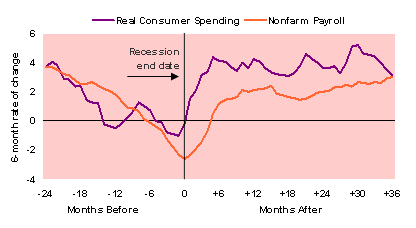
Real retail sales (that is, retail sales adjusted for inflation) are the "Holy Grail" of Leading Indicators for job growth. They have consistently turned at both tops and bottoms, an average of 3-5 months before job growth or losses turned. When real retail sales stay flat, they generate a lot of noise, and a longer period between the turn in sales and payrolls. Strong turns in sales generate reliable subsequent moves in payrolls in subsequent months. In general, with regard to recoveries, an increase of about +2.5% a year is necessary to reliably generate a subsequent move in real retail sales. In order to show you this relationship in the most comprehensive way, I am reproducing here graphs showing the entire 60 year record of real retail sales compared with jobs. With the sole exception of the 1961 recession, Real retail sales (the blue line) has consistently made peaks and troughs ahead of payrolls (the red line) ...
in the postwar period from 1948 through the 1962:
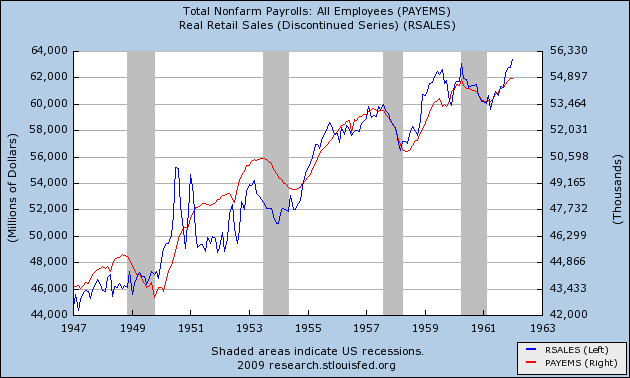
as it did during the 1970s recessions (ex the 1970 trough):
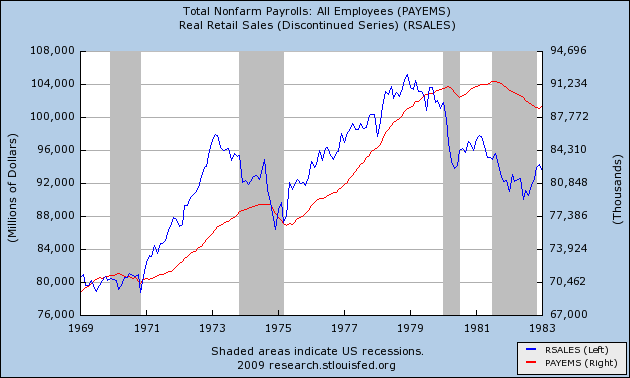
as it did during the 1991 and 2001 recessions and "jobless recoveries":
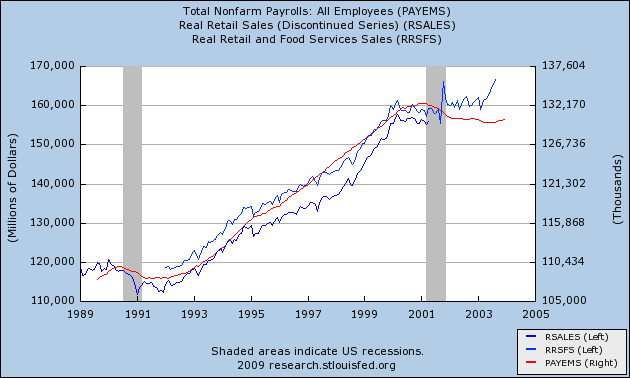
as it has done now:

On a three month smoothed average, Real retail sales bottomed in April of this year. This past week we learned that real retail sales through November are up 1.9% since then, for an annual rate of about 3.2% -- in other words, heralding actual job growth.
Another way of looking at the same data is to note that, in this Recession, employers have laid off employees exactly as if they were reacting to year-over-year retail sales data, as shown in this graph, where YoY real retail sales are in blue, and payroll gains/losses are in red:

I'm not claiming any deep rational relationship is portrayed in this last graph, just an extremely close fit of the two data series. If the correlation were to continue, then if real retail sales are merely flat this month, meaning they are up 1.9% YoY, payrolls would come over +100,000 (+/- 75,000 variance)! At very least, this is a very strong harbinger of a positive jobs reading.
II. Initial Jobless Claims
Initial jobless claims is weekly number of people who have applied for unemployment benefits for the first time after being laid off. These jobless claims have a good track record of predicting job gains. In those recoveries where jobless claims have fallen steeply, peak unemployment occurred within 2 months of the point where jobless claims fell 12% from the peak; but in those "jobless recoveries" where jobless claims has fallen slowly, peak unemployment occurred not at the 12% mark, but only when new jobless claims were more than 16% less than peak claims, and stayed more than 16% off for at least 3 months thereafter.
Here is a graph comparing this recession with the two previous "jobless recoveries" and the V shaped deep recession of 1982 in terms of initial jobless claims:

In the graph above, the blue lines represent the first 8 months after the peak in initial claims. The green lines represent the continuation of initial claims until the point where both jobs and the unemployment rate finally bottomed in the two "jobless recoveries." As you can see, jobless claims failed to penetrate the 20% off level except for a brief instance in summer 2002 (coinciding with a brief positive jobs number).
In our recession/expansion, initial claims declined 16% from their highs in October, and have declined more rapidly since then. As of this past week, initial jobless claims are off 29% from their April peak. This is not comparable at all to the two "jobless recoveries" but as of now is only comparable to 1983. In short, initial jobless claims are now also heralding actual job growth in the economy.
III. ISM Manufacturing
The ISM Manufacturing Index is a survey which asks purchasing managers for manufacturers if their business is getting better or worse, and contains a sub-index in which business indicate their hiring or firing intentions for the next month. It is a "diffusion index" in which 50 is the dividing line between expansion and contraction. In the very strong recovery after 1982, as well as during the weak recoveries of 1992 and 2002, the 53 level is the point where jobs began to be added. Further, a reading over 54 on the index has always coincided with actual job growth.
Additionally, whenever the hiring vs. firing sub-index is (- 5) or higher (i.e., no more than 5% more employers plan to fire than hire) and rising, where other evidence indicates a recession is ending, that has always indicated net employment growth was imminent, at least on a temproary basis; and also, whenever current staffing intentions were 65+. and hiring plans were 15+, that has always coincided with positive jobs numbers in the BLS survey, including during and after the "jobless recoveries" of 1992 and 2002.
The ISM manufacturing index expanded at 55.7 in October and 53.6 in November. (in the graph, the ISM reading of 53 - in blue - is normed to 100. The red lines represent job growth/losses in the noted recessions and recoveries):

This indicator too is heralding job growth.
IV. Industrial Production
Industrial production means exactly what it sounds like it does. It tends to peak a median +2 months before payrolls, and to trough at the end of recessions a median +1 month before payrolls. Of the 10 troughs since World War 2, in 8 of them industrial production troughed within 2 months of the payrolls number. Further, the only times that industrial production has led employment growth by a relatively long period of time, it has also shown weak growth -- less than 5% a year. In more typical V shaped job recoveries, it has grown at a rate of 10% or more a year.
This year, since bottoming in June, Industrial Production is up 3.6% for an annual rate of 8.7%. This is the best rate of expansion off a recession bottom since 1982, and far exceeds the 1992 and 2002 "jobless recoveries," as indicated in this graph of industrial production from 5 months before to 5 months after the bottom in each recession since 1982:

Industrial production is indeed having a "V" shaped recovery, meaning that it too -- the 4th of four indicators -- is heralding actual job growth.
V. Other signs: the Houshold Survey, Leading Indicators, Employment Trends Index vs. ISM Non-manufacturing, Okun's law
1. The Household Employment Survey
There are actually two surveys of employment conducted each month. While the typically reported number comes from the "Establishment survey" of employers, there is also a "household survey". The household survey has a wider measure of employment, so the two do not measure the exact same thing, but over time they are very closely correlated. More to our point, as noted by renowned bear David Rosenberg:
The Establishment Survey (nonfarm payrolls), has a “large company” bias that the companion Household Survey does not have. If you look at the historical record, you will find that at true turning points in the economic cycle, the Household Survey leads the Establishment Survey. This has always been the case heading into expansions and into recession....
Indeed, the household survey almost always turns either coincident with or one to two months before the establishment survey, as can be seen in this graph of the two prior "jobless recoveries":
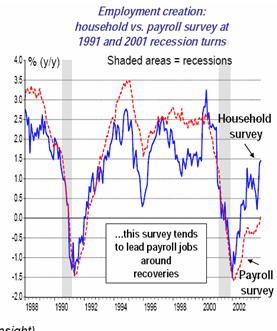
Although it was not reported widely at all, in fact the household survey (blue line) did indeed show +227,000 jobs added to the economy in November (payroll survey in red):

Together with all of the other above data, this appears to be strong confirmation that we are at a turning point.
2. Leading Indicators
The Index of Leading Economic Indicators is now up 8 months in a row, in is up 5.7% Year-over-year. This graph shows the index since 1992.

What is important for our purposes is that even as to the two "jobless recoveries", jobs were finally added (and briefly so in mid-2002) whenever the Index was up more than 5% YoY -- just as it is now.
It turns out that I am not the only one putting together an index specifically geared towards leading indicators for job growth. Within the last two years, the Conference Board (the private group which also calculates the LEI) also put together a historical series of indicators that have tended to signal job growth in the near future. Called the "employment trends index," the Conference Board reported this month that the
Emplyment Trends Index increased for the fourth consecutive month. The index now stands at 90.8, up 1.8 percent from the revised October figure.
Here is the most recent graph I could find, which omits the last few months.
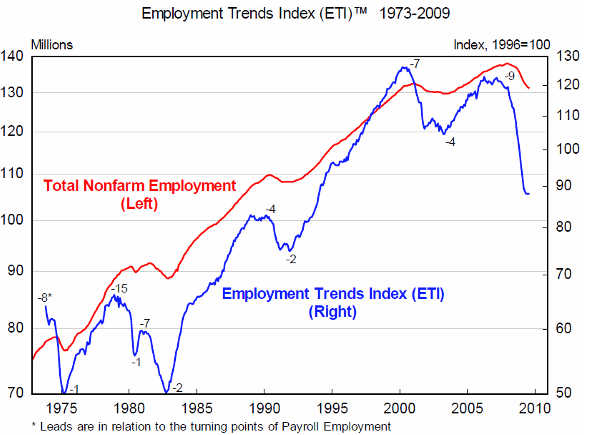
It is noteworthy that the series has always previously turned at bottoms 1 to 4 months before job growth. Since the indicator has turned up for the last 4 months, that again is yet another signal that the turn is here.
4. ISM Non manufacturing employment survey
No picture is perfect. While there is a wealth of data, discussed above, suggesting that the the bottom for jobs is occuring in the November-January window, there are a few contrary indicators.
Throughout the last ten years, the ISM Non-manufacturing employment index has been a close fit, especially on a three-month smoothed basis, to the jobs data. Here is the graph, through October,

In November, the Index was reported at 41.6, still showing strong contraction. This index is the one strong "yellow flag" compared with the other data. On the other hand, the series is only 15 years old, so we have no way to compere data with the 1991, 1982, or other prior recessions, so I have not weighted it that strongly.
5. Okun's Law
The other cautionary data point is "Okun's law", which generally holds that for every two percent gained/lost in GDP, unemployment changes by 1%. I have previously written at length about how, especially in the aftermath of offshoring, it takes 2% GDP measured on a YoY basis to result in the gain of one net job. As this graph of YoY GDP (green) vs. payroll gains/losses shows, even with 2.8% growth in the third quarter, and almost certain growth again this quarter, we won't be there.

While this is also a strong caution, on the other hand, Prof. James Hamilton of UCSD has written that:
the change in employment during this recession was noticeably more negative than the standard Okun's Law regression would predict. On the assumption that historical relationships reassert themselves, we surmise that employment could bounce back more strongly during this recovery
In other words, "Okun's law" was violated to the downside during the slump. For the long-term relationship to reassert itself, "Okun's law" may well be violated to the upside now. It is also worth noting that the Leading Indicators strongly suggest that growth will continue through the first quarter of next year. If that is true, then Q1 2010 may yet show +2% YoY GDP growth, which would not significantly violate the idea of job growth beginning now.
VI. Summary and Conclusion
In summary, all 4 of the leading indicators for actual job growth in the economy -- Real retail sales, Initial Jobless Claims (not shown), ISM manufacturing, and Industrial Production -- are now at the levels that portend job growth. This graph captures the percentage growth off the bottom for both real retail sales (blue, +1.9%), industrial production (green, +3.6%), the household employment survey (brown, +227,000 jobs), and the likely bottom, now, of payrolls (red):

It could be that November's (- 11,000) payrolls number is revised to a positive one (note that in all of the last 4 months, the initial reading has been revised by about +75,000); or it may be that the number doesn't bottom until January and turn up thereafter. But it certainly appears that the bottom for jobs is essentially right now.